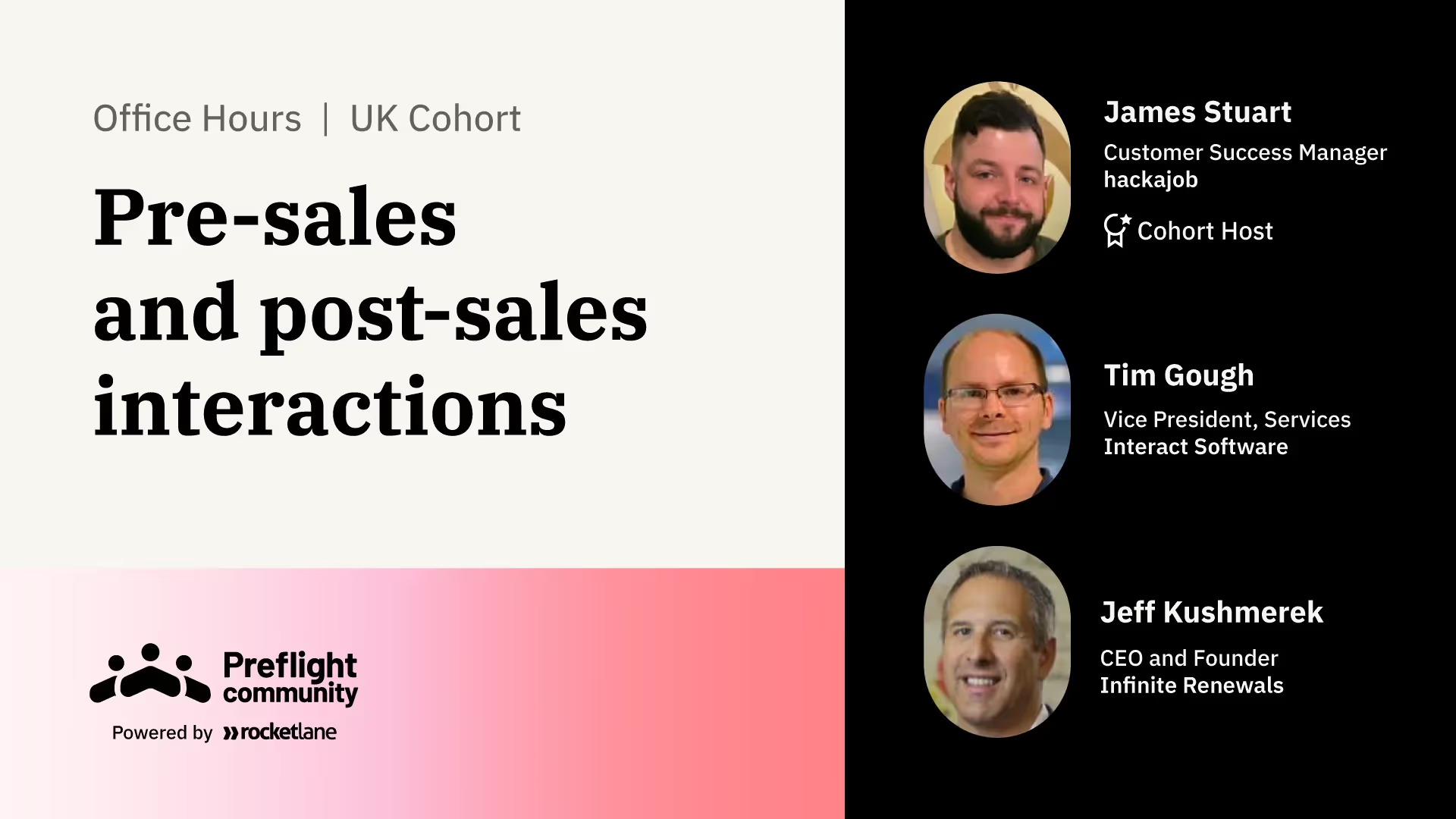In this session of Preflight UK’s Office Hours, James Stuart, CSM at hackajob spoke to Jeff Kushmerek, CEO and Founder at Infinite Renewals, and Tim Gough, VP - Services, at Interact, about how pre- and post-sales interactions impact your business and how companies can make the most of them.
Jeff set up Infinite Renewals to help emerging B2B SaaS companies reduce churn and increase recurring revenue and software adoption by launching customers efficiently and happily. Over the last 10 years, Jeff has worked with multiple companies to make continuous improvements to Customer Success and Professional Services teams while also helping Product and Presales teams impact customer satisfaction and retention.
With a background in digital communications, across private and public sector organizations, over the last 25 years, Tim has been working in program and project management roles that walk the line between the pre and post-sales world.
Here are our top takeaways from the session.
1. Why you need implementation teams to participate in the presales stage
Better discovery and reduced risk of churn
Product fit issues are a big reason for churn. This normally happens because the discovery call was weak. Bringing in the right resources in the presale phase means that it can also be turned into a discovery phase. At this stage, the implementation team can get the prospect to think about the right value expectations for their leadership as a business case.
Additionally, it can help customers have clearer expectations of what needs to be done at their end – for integrations, data exchange/migrations, and other business processes.
Trust building
Interacting with the people who will eventually implement the software for them can help build more faith in the sale. Additionally, the fact that these teams/professionals don't work on commissions makes it easier for customers to trust them.
Improved and faster implementation
By participating in the presale discussion, PS and Implementation teams can better understand the business problem being solved.
Expectation gaps or mismatches in the post-sale stage could mean that customer teams need to consult with their key stakeholders at multiple points post-sale – delaying the implementation process.
Setting the right expectations and telling customers exactly what preparations need to be done at the end shaves time off implementation.
2. Best practices for the presale stage
- While involving the implementation team, ensure that they share a deck with the project plan, an overview of the implementation/onboarding process, and customer logos (references of successful customers).
- Use the jobs-to-be-done framework with customers to understand their actual business use case(s).
3. Best practices for the implementation stage
- Involve the CSMs from Day 1 of implementation to avoid the risk of the implementation process being reduced to a merely tactical exercise. This way, they can drive real growth and strategic decisions from the outset.
- Build an MVP version based on best practices based on the discovery in the presales process and present it to the senior executives in the customer team.
- Share a Statement of Work (SOW) that outlines the scope of the onboarding and implementation process. Make sure to cover key responsibilities like data cleaning, migration, etc.
- KPI your internal team for process adherence: For example, you could link a high percentage of their bonus to this. Use weekly audits that track template usage, task deviations, etc., to manage expectations within your team.
- Charge for implementation: If you say, ‘Jim is your Implementation Consultant for 3 months for 10K’, you’d be more likely to see customers exhibit higher engagement, accountability, and urgency.
- Focus on highlighting early wins to the customer’s leadership team.
4. Mistakes to avoid during implementation
Not having a set process or timeline for implementation
As Jeff put it, if everything you do is one-off or custom, you don’t really have a product; you have a white-label solution.
Have a consistent, easily repeatable, and visible process. Make sure you have processes that are consistent, regardless of who’s running the implementation. Templates are a great way to do that.
Additionally, find ways to ensure project visibility, so customers know what is happening, and what needs to be done at all stages of the process.
Not having the right skillsets within the team
Define internal roles and responsibilities correctly. Whether it is to manage technical aspects of implementation, project management, or to ensure clear customer communication and accountability, make sure your team has the right skillsets for the different demands of implementation.
Not pushing customers enough
Don't be afraid to tell customers if they are not following best practices. Enterprise customers expect to be directed by you. Communicate where they would be if they followed best practices and where they are.
5. Best practices for the growth and adoption phase
For enterprise customers, remember that you’ll need to repeatedly roll out new sets of users and identify new use cases and projects. Ensure that you have systems and processes to facilitate this seamlessly.
Don’t let QBRs be reduced to another tickbox activity: Use them for what they really are: an opportunity to show value.
- Ensure that key stakeholders are present at QBRs.
- Take the time to narrow down the right data points to include in the QBR deck. Besides asking your customer what they’d like to see in the QBR, involve your marketing team to understand the key usage statistics they need. Use data from user surveys or quotes from super users to use within the QBR.
- Ensure that QBR-related data collection is repeatable throughout the customer journey.
- Have enough talking points for each QBR. For instance, providing automated reports to admins just before the QBR can trigger the right conversations at the meeting.






















.webp)
